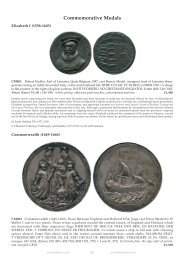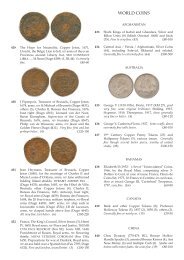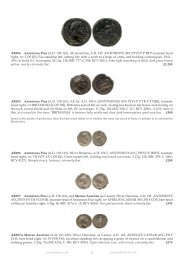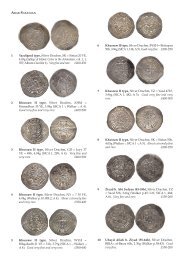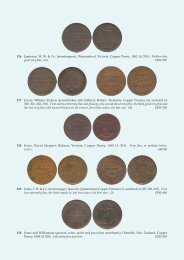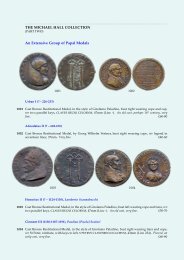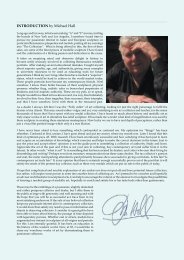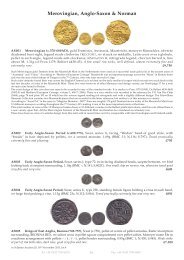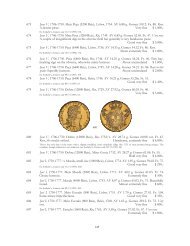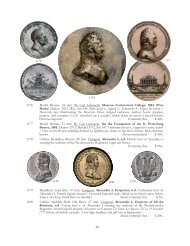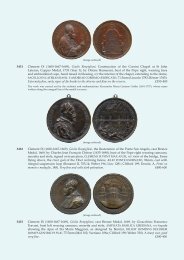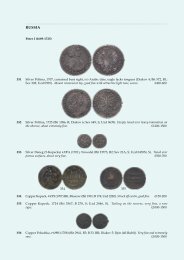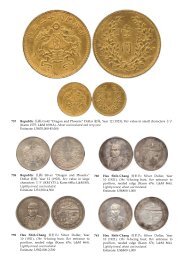ORDERS, DECORATIONS AND MEDALS - Baldwin's
ORDERS, DECORATIONS AND MEDALS - Baldwin's
ORDERS, DECORATIONS AND MEDALS - Baldwin's
You also want an ePaper? Increase the reach of your titles
YUMPU automatically turns print PDFs into web optimized ePapers that Google loves.
3210 3211<br />
3210 Scarce and Interesting NGS and Arctic Exploration group of three awarded to Corporal John<br />
Thomas, Royal Marines, aboard HMS Plover during the search for Franklin’s Lost Expedition<br />
(1847-54), comprising: Naval General Service Medal, 1793-1840, single clasp, Syria (John Thomas),<br />
Arctic Medal 1818-55, unnamed as issued, St Jean D’ Acre Medal, 1840, in copper, unnamed as<br />
issued, with contemporary straight bar suspension. Group well-toned, second good fine, the others<br />
good very fine. (3) £800-1000<br />
CorporalJohnThomaswasborninNarbeth,Pembrokeshire,Wales,inMarch1819.HeattestedforserviceasaPrivatein76Company,<br />
TheRoyalMarines,atBathonthe11 th ofNovember,1837–attheageof18.Hesoonsawactiveserviceaboardthe74-gunHMS Revenge,<br />
which was involved in the naval activities off the coast of Syria in 1840, including its blockade and the bombardment of Acre.<br />
Later in his career he was sent on several expeditions to the Arctic region between 1848 and 1854 as part of the crew of HMS<br />
Plover. The Plover was sent along with HMS Herald as part of the western search for Franklin’s lost expedition, which had<br />
disappeared following its departure in 1845, with the aim of discovering the North West Passage. During 1849 Plover and Herald<br />
traversed the Bering Strait, proceeded to Chamisso Island and then onto the Dease inlet, but still found no trace of the apparently<br />
doomed Franklin expedition.<br />
The two ships re-explored the same area in 1850, but without success in their original aim. This trip did however prove to be a most<br />
useful ethnographic study of the local Iñupiaq Eskimo of that region, upon whom they had relied heavily during their searches.<br />
These searches continued in vain during the easier summer months each year following until 1854, wintering at Port Clarence<br />
(1851-1852) and later at Point Barrow (1852-1854). Corporal Thomas then returned home to Britain and was discharged from<br />
further service at Deal on the 25 th of April, 1855, at the age of 36, presumably exhausted from his years spent in the Arctic.<br />
Sold with a quantity of research detailing the activities of HMS Plover in the Arctic, copy service and discharge papers and<br />
relevant documents confirming these awards and entitlements. These medals sold as a complete group by the family, complete<br />
with an earlier A H Baldwin & Sons valuation dated 6 th of October, 1938, considering the medals worth 25/-, and worthy of<br />
further research.<br />
3211 Great War Nursing Trio awarded to Sister Alice L. Philpotts (MiD), New Zealand Expeditionary<br />
Force, comprising: 1914-15 Star (22/157 Sister A. L. Philpotts. N.Z.E.F.); British War and Victory<br />
Medals, and MiD bronze spray of oak leaves, medals individually court mounted on board. Star with<br />
minor reverse adhesive stain and slight edge bruise to VM at 9 o’clock, good very fine. (3) £300-350<br />
MiD London Gazette 28.12.1917 for ‘devotion to duty during the period of February 26 th to 20 th September, 1917’<br />
Sister Alice Lizzy Philpotts was born on the 20 th of September, 1892 in Picton, near Blenheim, on the South Island of New Zealand.<br />
The daughter of a prominent local figure who had opened a local Church School and later became Mayor, Alice Philpotts trained<br />
as a Nurse in Wellington, qualifying in 1910. After the outbreak of the Great War, in 1915 she was sent as part of the New Zealand<br />
Army Nursing Service (NZANS) with the NZEF to serve in Egypt – leaving with 67 other nurses on the hospital ship Maheno.<br />
She was stationed for some time at the New Zealand General Hospital in Cairo, Egypt, an important centre used for the treatment<br />
of casualties from the Gallipoli campaign. She was later sent to the Western Front, where she spent some 18 months serving in a<br />
number of stationary hospitals (which were generally in forward positions nearer the front lines) at Rouen, and later nearAbbeville,<br />
and Hardelot in the Somme area. Being stationed very close to the front lines, her hospitals had come under shellfire on more<br />
than one occasion. It was here that through her sterling work she was considered for a mention in despatches for her ‘devotion<br />
to duty’ during 1917, a period which included the New Zealand Division’s attack upon Messines Ridge in June that year.<br />
Receiving news that her father had become seriously ill, she returned to New Zealand for a short spell until his death in late<br />
1917, upon which she returned to France until the end of the war. Sister Alice Philpotts then continued to work in England,<br />
specialising in the massage and rehabilitation of wounded servicemen until her discharge on the 1 st of February 1920, when she<br />
returned to New Zealand, taking up the position of Matron at Christ’s College, Christchurch until her retirement. Returning to<br />
live with her family in Blenheim, Alice Philpotts died in the summer of 1956.<br />
Sold with copy service papers and other useful information.



